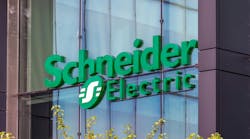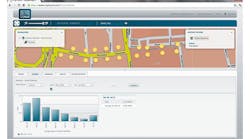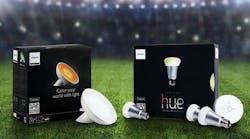Latest from Industry
Philips Lighting made some significant advances last week in building out the ecosystem around its connected lighting platforms with announcements of partnerships with high-profile technology and appliance companies. The deals with Cisco, SAP and Bosch relate to Philips’ office lighting systems, street lighting networks and its Hue connected lighting platform, respectively.
Philips announced a global strategic alliance with Cisco Systems to pursue energy savings, building efficiency and employee productivity advances made possible by the Internet of Things (IoT) in modern offices. The companies will combine Philips’ connected office lighting system using power-over-Ethernet (PoE) technology with Cisco’s network technology. Lighting fixtures in the Philips system equipped with sensors and software applications can be connected using Cisco technologies.
As a demonstration of the concept, Cisco is installing a Philips connected lighting system at its Canadian headquarters in Toronto. Philips and Cisco will also collaborate on a joint go-to-market strategy.
“Our alliance has two of the world’s biggest and trusted lighting and connectivity brands working together to bring the Internet of Things to life in offices and commercial buildings across the world,” Bill Bien, senior V.P. and head of strategy and marketing at Philips Lighting, said in a press release. “Customers will receive the best energy-efficient lighting experience in the connected world and be able to use information acquired from their connected lighting system to save energy, reduce costs, improve productivity and optimize their workspace environment. Lighting connected to highly secure, reliable IT infrastructure will form the backbone of the smart office of the future.”
On the streetlight side, SAP will collaborate with Philips to link real-time information from Philips connected street lights with data from other sensors in a single integrated city dashboard to help cities gather information. The joint offering combines real-time situational awareness based on the SAP HANA platform with the Philips CityTouch street lighting management system to give planners a 360-degree view of data — such as street lighting, parking and traffic controls — to plan better and manage costs.
The agreement between Philips and SAP started in Buenos Aires, Argentina, where Philips is refurbishing 91,000 streetlights with LEDs, controlled by its CityTouch network to interface directly with the SAP HANA platform. Buenos Aires is able to manage more than 700,000 assets, including street lights, parks, bus stops, buildings and bridges. For example, by analyzing real-time sensor data, the city can monitor storm drains to mitigate risks caused by heavy rains. CityTouch allows remote management of each individual street light point, which allows remote adjustment of lighting levels, dramatically reducing energy consumption and maintenance costs. As a result, Buenos Aires has been able to increase operational efficiency, realize energy savings of over 50% and greatly improve safety and quality of life for its 13 million residents.
Philips also announced that heating and appliance manufacturer Bosch has joined its Friends of Hue family, an agreement to make Bosch products compatible with the Hue connected lighting system primarily used in residential applications. This collaboration will allow Philips Hue customers to connect their lighting with the heating system in the house.
The combination will make connected lighting and heating behave as one system. For example, customers can have their Philips Hue lights dim down as the temperature in the home rises, and if users are away from home longer than usual, the Bosch Smart Home system will recognize this and activate the lighting to simulate somebody being at home, helping to deter burglars, the companies said in a release.
Lighting is proven to be the number one interest of the connected home, Philips said. Through the Hue partnership and developers programs it now has more than 450 third party apps available to operate the system.











